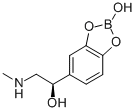| Identification | Back Directory | [Name]
(R)-2-hydroxy-alpha-[(methylamino)methyl]-1,3,2-benzodioxaborole-5-methanol | [CAS]
5579-16-8 | [Synonyms]
epinephryl borate
5-[(1R)-1-Hydroxy-2-(methylamino)ethyl]-2-hydroxy 1,3,2-benzodioxaborole
(R)-2-hydroxy-alpha-[(methylamino)methyl]-1,3,2-benzodioxaborole-5-methanol | [EINECS(EC#)]
226-961-8 | [Molecular Formula]
C9H12BNO4 | [MDL Number]
MFCD00864146 | [MOL File]
5579-16-8.mol | [Molecular Weight]
209.007 |
| Hazard Information | Back Directory | [Originator]
Eppy,Barnes Hind,US,1961 | [Uses]
Adrenergic. | [Manufacturing Process]
Epinephrine may be made by isolation from animal adrenal glands or may be
synthesized as described by Payne in Ind. Chemist, 37, 523 (1961).
It has been found that epinephrine solutions having a physiological pH and
which are stable for months in storage can be prepared by combining with the
epinephrine a small amount of sodium bisulfite, boric acid, and oxine (8-
hydroxy-quinoline) hereinafter called 8-quinolinol and adjusting the pH with
an alkali, such as sodium hydroxide, to the desired pH.
It has been found that from 0.001 to 0.1% of 8-quinolinol can be used. From
0.2 to 5% boric acid may be used. The amount of sodium bisulfite can be
varied from 0.1 to 1%. The solutions can contain from 0.1 to 4% epinephrine.
The pHs of the solutions can be adjusted to any value within the physiological
range, i.e., from 6.5 to 8.5 using any convenient alkali such as sodium
hydroxide. | [Brand name]
Epinal (Alcon); Eppy/N(Pilkington Barnes Hind). | [Therapeutic Function]
Antiglaucoma |
|
|





